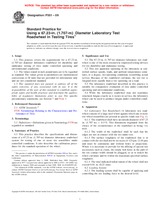We need your consent to use the individual data so that you can see information about your interests, among other things. Click "OK" to give your consent.
ASTM F551-09
Standard Practice for Using a 67.23-in. (1.707-m) Diameter Laboratory Test Roadwheel in Testing Tires
STANDARD published on 1.6.2009
The information about the standard:
Designation standards: ASTM F551-09
Note: WITHDRAWN
Publication date standards: 1.6.2009
SKU: NS-55688
The number of pages: 3
Approximate weight : 9 g (0.02 lbs)
Country: American technical standard
Category: Technical standards ASTM
Annotation of standard text ASTM F551-09 :
Keywords:
durability, endurance, laboratory tire testing, structural fatigue, testing tires, Diameter, Durability, Endurance, Interlaboratory testing--rubber/carbon black, Nominal diameter (in materials/analysis), Roadwheel, Tire testing, ICS Number Code 83.160.01 (Tyres in general)
Additional information
| Significance and Use | ||
|
The 67.23-in. (1.707-m) diameter laboratory test roadwheel is one of the most extensively employed testing devices for tire durability and endurance testing. This test apparatus operating in the laboratory at controlled surface speeds, loads, and ambient temperatures simulates, to a degree, tire-operating conditions resembling actual service. Because of the roadwheel curvature, the test tire is fatigued more rapidly than a tire operating on a road. The laboratory roadwheel described in this practice is suitable for comparative evaluation of tires under controlled operating and environmental conditions. While the laboratory roadwheel may not reproduce structural fatigue exactly as it occurs in service, the laboratory wheel can be used to produce fatigue under controlled conditions. |
||
| 1. Scope | ||
|
1.1 This practice covers the requirements for a 67.23-in. (1.707-m) diameter laboratory roadwheel for durability and endurance testing of tires under controlled operating and environmental conditions. 1.2 The values stated in inch-pound units are to be regarded as standard. The values given in parentheses are mathematical conversions to SI units that are provided for information only and are not considered standard. 1.3 This standard does not purport to address all of the safety concerns, if any, associated with its use. It is the responsibility of the user of this standard to establish appropriate safety and health practices and determine the applicability of regulatory limitations prior to use. For specific precautionary statements, see Section 7 and Note 1. |
||
| 2. Referenced Documents | ||
|
We recommend:
Technical standards updating
Do you want to make sure you use only the valid technical standards?
We can offer you a solution which will provide you a monthly overview concerning the updating of standards which you use.
Would you like to know more? Look at this page.




 Cookies
Cookies
